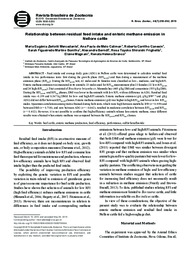Relationship between residual feed intake and enteric methane emission in Nellore cattle.
Relationship between residual feed intake and enteric methane emission in Nellore cattle.
Author(s): MERCADANTE, M. E. Z.; CALIMAN, A. P. de M.; CANESIN, R. C.; BONILHA, S. F. M.; BERNDT, A.; FRIGHETTO, R. T. S.; MAGNANI, E.; BRANCO, R. H.
Summary: Residual feed intake (RFI) is an attractive measure of feed efficiency, as it does not depend on body size, growth rate, or body composition measures (Durunna et al., 2012). High-efficiency animals exhibit low RFI and consume less feed than expected for maintenance and production, whereas low-efficiency animals have high RFI and observed feed intake higher than the predicted feed intake. The possibility of improving production efficiency by exploiting the genetic variation in RFI and possible variation in traits related to emission of greenhouse gases is of great economic importance for beef cattle production. Studies have shown that selection of animals for low RFI (high feed efficiency) reduces methane emissions in cattle (Nkrumah et al., 2006; Hegarty et al., 2007; Fitzsimons et al., 2013). However, there are inconsistencies in relation to differences in feed intake and corresponding methane emissions between low- and high-RFI animals. Fitzsimons et al. (2013) offered grass silage to heifers and observed that both DMI and methane emission (g/d) were lower for low-RFI compared with high-RFI animals, and Jones et al. (2011) reported that DMI was similar between divergent RFI groups and that methane emission was similar when animals grazed low-quality pastures but were lower for low- RFI compared with high-RFI animals when grazing highquality pastures. The conflicting observations regarding the variation in methane emission of high- and low-efficiency animals between studies suggest that selection of cattle for increasing feed efficiency does not necessarily result in a reduction in methane emission (Freetly and Brown- Brandl, 2013). To date, published studies relating RFI and methane emission are limited to Bos taurus cattle, and little information is available on Bos indicus cattle. In view of these considerations, the objective of the present study was to evaluate the relationship between enteric methane emission and residual feed intake in Nellore cattle fed a high-roughage diet.
Publication year: 2015
Types of publication: Journal article
Observation
Some of Embrapa's publications are published as ePub files. To read them, use or download one of the following free software options to your computer or mobile device. Android: Google Play Books; IOS: iBooks; Windows and Linux: Calibre.
Access other publications
Access the Agricultural Research Database (BDPA) to consult Embrapa's full library collection and records.
Visit Embrapa Bookstore to purchase books and other publications sold by Embrapa.

